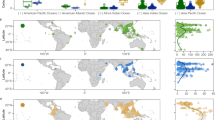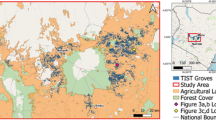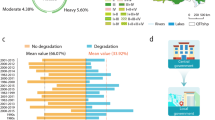Abstract
Afforestation and reforestation projects in the karst regions of southwest China aim to combat desertification and improve the ecological environment. However, it remains unclear at what scale conservation efforts have impacted on carbon stocks and if vegetation regrowth occurs at a large spatial scale as intended. Here we use satellite time series data and show a widespread increase in leaf area index (a proxy for green vegetation cover), and aboveground biomass carbon, which contrasted negative trends found in the absence of anthropogenic influence as simulated by an ecosystem model. In spite of drought conditions, aboveground biomass carbon increased by 9% (+0.05 Pg C y−1), mainly in areas of high conservation effort. We conclude that large scale conservation projects can contribute to a greening Earth with positive effects on carbon sequestration to mitigate climate change. At the regional scale, such ecological engineering projects may reduce risks of desertification by increasing the vegetation cover and reducing the ecosystem sensitivity to climate perturbations.
This is a preview of subscription content, access via your institution
Access options
Access Nature and 54 other Nature Portfolio journals
Get Nature+, our best-value online-access subscription
$29.99 / 30 days
cancel any time
Subscribe to this journal
Receive 12 digital issues and online access to articles
$119.00 per year
only $9.92 per issue
Buy this article
- Purchase on Springer Link
- Instant access to full article PDF
Prices may be subject to local taxes which are calculated during checkout




Similar content being viewed by others
References
Martinez-Ramos, M. et al. Anthropogenic disturbances jeopardize biodiversity conservation within tropical rainforest reserves. Proc. Natl Acad. Sci. USA 113, 5323–5328 (2016).
Fang, J. et al. Forest biomass carbon sinks in East Asia, with special reference to the relative contributions of forest expansion and forest growth. Glob. Change Biol. 20, 2019–2030 (2014).
Zhou, L. et al. Widespread decline of Congo rainforest greenness in the past decade. Nature 509, 86–90 (2014).
Piao, S. et al. Detection and attribution of vegetation greening trend in China over the last 30 years. Glob. Change Biol. 21, 1601–1609 (2015).
Schwalm, C. R. et al. Global patterns of drought recovery. Nature 548, 202–205 (2017).
Doughty, C. E. et al. Drought impact on forest carbon dynamics and fluxes in Amazonia. Nature 519, 78–82 (2015).
Kharin, V. V., Zwiers, F. W., Zhang, X. & Hegerl, G. C. Changes in temperature and precipitation extremes in the IPCC ensemble of global coupled model simulations. J. Clim. 20, 1419–1444 (2007).
Seddon, A. W. R., Macias-Fauria, M., Long, P. R., Benz, D. & Willis, K. J. Sensitivity of global terrestrial ecosystems to climate variability. Nature 531, 229–232 (2016).
Lloret, F., Escudero, A., Iriondo, J. M., Martínez-Vilalta, J. & Valladares, F. Extreme climatic events and vegetation: the role of stabilizing processes. Glob. Change Biol. 18, 797–805 (2012).
Zhu, Z. et al. Greening of the Earth and its drivers. Nat. Clim. Change 6, 791–795 (2016).
Liu, Y. Y. et al. Recent reversal in loss of global terrestrial biomass. Nat. Clim. Change 5, 470–474 (2015).
Fensholt, R. et al. Greenness in semi-arid areas across the globe 1981–2007 — an Earth Observing Satellite based analysis of trends and drivers. Remote Sens. Environ. 121, 144–158 (2012).
Brandt, M. et al. Human population growth offsets climate-driven increase in woody vegetation in sub-Saharan Africa. Nat. Ecol. Evol. 1, 0081 (2017).
Hansen, M. C. et al. High-resolution global maps of 21st-century forest cover change. Science 342, 850–853 (2013).
Tong, X. et al. Quantifying the effectiveness of ecological restoration projects on long-term vegetation dynamics in the karst regions of southwest China. Int. J. Appl. Earth Obs. Geoinf. 54, 105–113 (2017).
Ouyang, Z. Y. et al. Improvements in ecosystem services from investments in natural capital. Science 352, 1455–1459 (2016).
Hua, F. et al. Opportunities for biodiversity gains under the world’s largest reforestation programme. Nat. Commun. 7, 12717 (2016).
Moore, J. C. et al. Will China be the first to initiate climate engineering? Earth’s Future 4, 588–595 (2016).
Xu, W. et al. Strengthening protected areas for biodiversity and ecosystem services in China. Proc. Natl Acad. Sci. USA 114, 1601–1606 (2017).
Jiang, Z. C., Lian, Y. Q. & Qin, X. Q. Rocky desertification in Southwest China: Impacts, causes, and restoration. Earth Sci. Rev. 321, 1–12 (2014).
Sweeting M. M. Karst in China: Its Geomorphology and Environment (Springer, Berlin, New York, 2012).
Miao, Z. L. Xu Xiake’s contributions to karst study in Southwestern China. Geogr. Res. 5, 18–24 (1986).
Zhang, C., Qi, X., Wang, K., Zhang, M. & Yue, Y. The application of geospatial techniques in monitoring karst vegetation recovery in southwest China: a review. Progr. Phys. Geogr. 41, 450–477 (2017).
Delang, C. O. & Yuan, Z. China’s Grain for Green Program (Springer, Heidelberg, 2015).
Yan, K. et al. Evaluation of MODIS LAI/FPAR Product Collection 6. Part 1: consistency and improvements. Remote Sens. 8, 359–16 (2016).
Smith, B. et al. Implications of incorporating N cycling and N limitations on primary production in an individual-based dynamic vegetation model. Biogeosciences 11, 2027–2054 (2014).
de Jong, R., Verbesselt, J., Zeileis, A. & Schaepman, M. E. Shifts in global vegetation activity trends. Remote Sens. 5, 1117–1133 (2013).
Beguería, S., Vicente-Serrano, S. M., Reig, F. & Latorre, B. Standardized precipitation evapotranspiration index (SPEI) revisited: parameter fitting, evapotranspiration models, tools, datasets and drought monitoring. Int. J. Climatol. 34, 3001–3023 (2014).
Grogan, K., Pflugmacher, D., Hostert, P., Kennedy, R. & Fensholt, R. Cross-border forest disturbance and the role of natural rubber in mainland Southeast Asia using annual Landsat time series. Remote Sens. Environ. 169, 438–453 (2015).
Peng, S. et al. Recent change of vegetation growth trend in China. Environ. Res. Lett. 6, 044027 (2011).
Zhang, Y. et al. Multiple afforestation programs accelerate the greenness in the ‘Three North’ region of China from 1982 to 2013. Ecol. Indic. 61, 404–412 (2016).
Xiao, J. Satellite evidence for significant biophysical consequences of the ‘Grain for Green’ Program on the Loess Plateau in China. J. Geophys. Res. Biogeosci. 119, 2014JG002820 (2014).
Li, S. et al. Vegetation changes in recent large-scale ecological restoration projects and subsequent impact on water resources in China’s Loess Plateau. Sci. Total Environ. 569–570, 1032–1039 (2016).
Cai, H., Yang, X., Wang, K. & Xiao, L. Is forest restoration in the Southwest China Karst promoted mainly by climate change or human-induced factors? Remote Sens. 6, 9895–9910 (2014).
Meyfroidt, P. & Lambin, E. F. Forest transition in Vietnam and its environmental impacts. Glob. Change Biol. 14, 1319–1336 (2008).
Bulletin of China’s Rocky Desertification (State Forestry Administration of China, 2012); http://www.forestry.gov.cn/portal/zsxh/s/3445/content-548741.html.
Houghton, R. A. & Nassikas, A. A. Global and regional fluxes of carbon from land use and land cover change 1850–2015. Glob. Biogeochem. Cycles 31, 2016GB005546 (2017).
Yan, K. et al. Evaluation of MODIS LAI/FPAR Product Collection 6. Part 2: validation and intercomparison. Remote Sens. 8, 460–426 (2016).
Myneni, R. B. et al. Global products of vegetation leaf area and fraction absorbed PAR from year one of MODIS data. Remote Sens. Environ. 83, 214–231 (2002).
Samanta, A. et al. Comment on ‘drought-induced reduction in global terrestrial net primary production from 2000 through 2009’. Science 333, 1093–1093 (2011).
Zhu, Z. et al. Global data sets of vegetation leaf area index (LAI)3g and fraction of photosynthetically active radiation (FPAR)3g derived from global inventory modeling and mapping studies (GIMMS) normalized difference vegetation index (NDVI3g) for the period 1981 to 2011. Remote Sens. 5, 927–948 (2013).
Tian, F., Brandt, M., Liu, Y. Y., Rasmussen, K. & Fensholt, R. Mapping gains and losses in woody vegetation across global tropical drylands. Glob. Change Biol. 4, 1748–1760 (2017).
Baccini, A. et al. Estimated carbon dioxide emissions from tropical deforestation improved by carbon-density maps. Nat. Clim. Change 2, 182–185 (2012).
Breiman, L. Arcing the Edge (Statistics Department, Univ. California, Berkeley, 1997).
Vicente-Serrano, S. M., Beguería, S., López-Moreno, J. I., Angulo, M. & El Kenawy, A. A New global 0.5° gridded dataset (1901–2006) of a multiscalar drought index: comparison with current drought index datasetsbased on the palmer drought severity index. J. Hydrometeor. 11, 1033–1043 (2010).
Harris, I., Jones, P. D., Osborn, T. J. & Lister, D. H. Updated high-resolution grids of monthly climatic observations – the CRU TS3.10 dataset. Int. J. Climatol. 34, 623–642 (2014).
Farquhar, G. D., Von Caemmerer, S. & Berry, J. A. A biochemical model of photosynthetic CO2 assimilation in leaves of C3 species. Planta 149, 8–90 (1980).
Haxeltine, A. & Prentice, I. C. A general model for the light-use efficiency of primary production. Func. Ecol. 10, 551–561 (1996).
Lamarque, J.-F. et al. Multi-model mean nitrogen and sulfur deposition from the Atmospheric Chemistry and Climate Model Intercomparison Project (ACCMIP): evaluation of historical and projected future changes. Atmos. Chem. Phys. 13, 7997–8018 (2013).
Etheridge, D. M. et al. Natural and anthropogenic changes in atmospheric CO2 over the last 1000 years from air in Antarctic ice and firn. J. Geophys. Res. Atmos. 101, 4115–4128 (1996).
Keeling, C. D., Whorf, T. P., Wahlen, M. & van der Plichtt, J. Interannual extremes in the rate of rise of atmospheric carbon dioxide since 1980. Nature 375, 666–670 (1995).
Keenan, T. F. et al. Recent pause in the growth rate of atmospheric CO2 due to enhanced terrestrial carbon uptake. Nat. Commun. 7, 13428 (2016).
Liu, J., Li, S., Ouyang, Z., Tam, C. & Chen, X. Ecological and socioeconomic effects of China’s policies for ecosystem services. Proc. Natl Acad. Sci. USA 105, 9477–9482 (2008).
Xu, Z., Bennett, M. T., Tao, R. & Xu, J. China’s sloping land conversion program four years on: current situation and pending issues. Int. Forest. Rev. 6, 317–326 (2004).
Trac, C. J., Harrell, S., Hinckley, T. M. & Henck, A. C. Reforestation programs in southwest China: reported success, observed failure, and the reasons why. J. Mt. Sci. 4, 275–292 (2007).
Acknowledgements
The study was funded by the National Key Research and Development Program of China (no. 2016YFC0502400) and National Natural Science Foundation of China (no. 41471445, 41371418) and Science and Technology Service Network Initiative of Chinese Academy of Sciences (no. KFJ-STS-ZDTP-036). M.B. received funding from the European Union’s Horizon 2020Research and Innovation programme under Marie Sklodowska-Curie grant agreement no. 656564. R.F. acknowledges funding from the Danish Council for Independent Research (DFF) grant iD: DFF–6111-00258.
Author information
Authors and Affiliations
Contributions
X.T., M.B., R.F., S.H., Y.Y., W.K. and K.W. designed the study. X.T., S.H. (BFAST), W.K. and G.S. (LPJ) conducted the analyses with support from F.T., Y.Y., M.B. and R.F. MODIS and LAI data were prepared by R.M. and C.C.; M.B. and X.T. drafted the manuscript, which was edited by R.F., S.H., W.K., Y.Y., G.S., F.T., Z.S., X.X., C.C., H.C. and Y.L.
Corresponding authors
Ethics declarations
Competing interests
The authors declare no competing financial interests.
Additional information
Publisher’s note: Springer Nature remains neutral with regard to jurisdictional claims in published maps and institutional affiliations.
Supplementary information
Supplementary Information
Supplementary Figs. 1–6 and Tables 1,2
Rights and permissions
About this article
Cite this article
Tong, X., Brandt, M., Yue, Y. et al. Increased vegetation growth and carbon stock in China karst via ecological engineering. Nat Sustain 1, 44–50 (2018). https://doi.org/10.1038/s41893-017-0004-x
Received:
Accepted:
Published:
Issue Date:
DOI: https://doi.org/10.1038/s41893-017-0004-x
This article is cited by
-
Irrigation expansion has kept pace with the CO2 fertilization effect on vegetation growth in a typical arid region
Environmental Sciences Europe (2024)
-
Climate-induced tree-mortality pulses are obscured by broad-scale and long-term greening
Nature Ecology & Evolution (2024)
-
Trees on smallholder farms and forest restoration are critical for Rwanda to achieve net zero emissions
Communications Earth & Environment (2024)
-
Evaluate the differences in carbon sink contribution of different ecological engineering projects
Carbon Research (2024)
-
The structure and development of Loess Critical Zone and its soil carbon cycle
Carbon Neutrality (2024)



